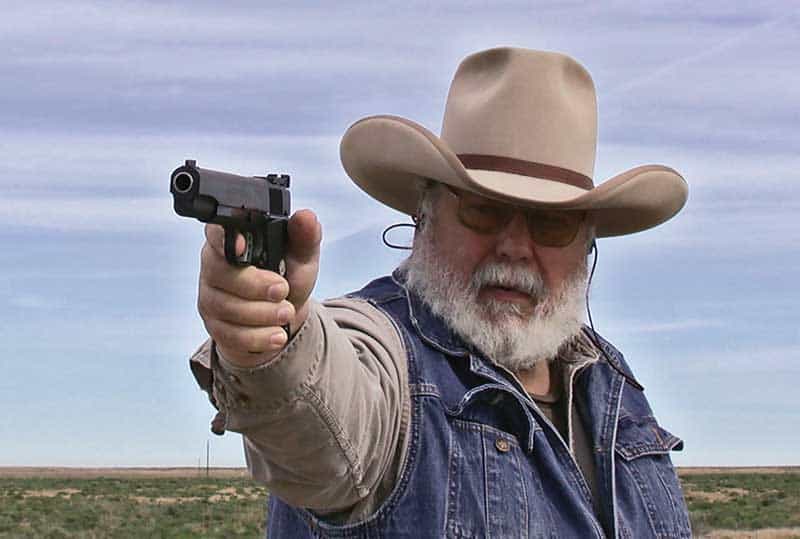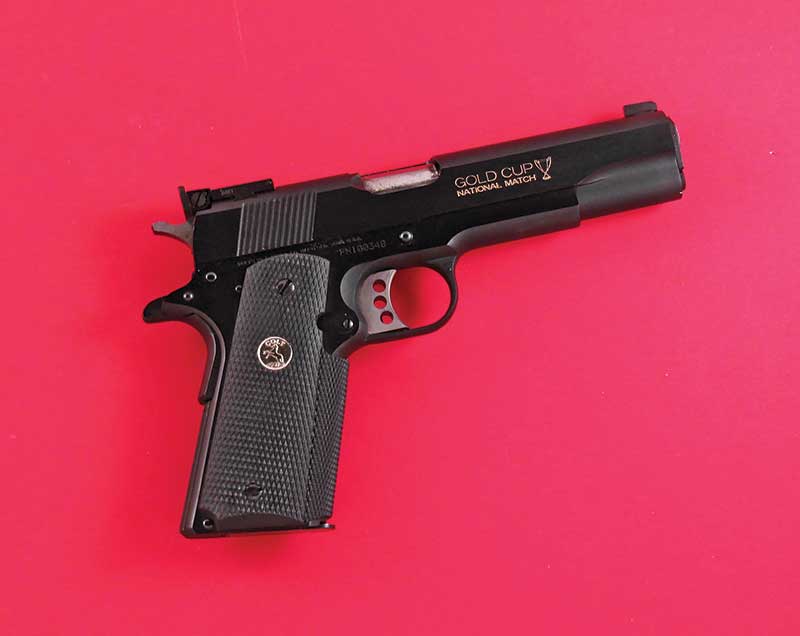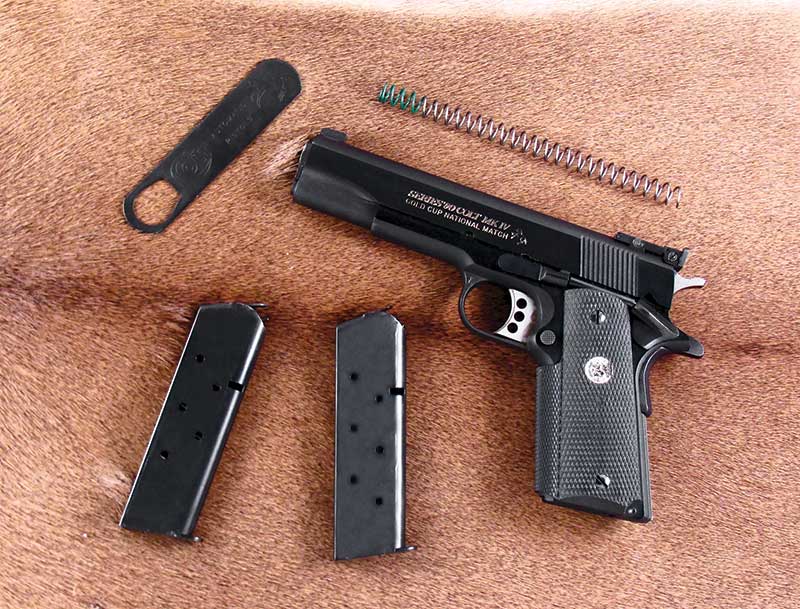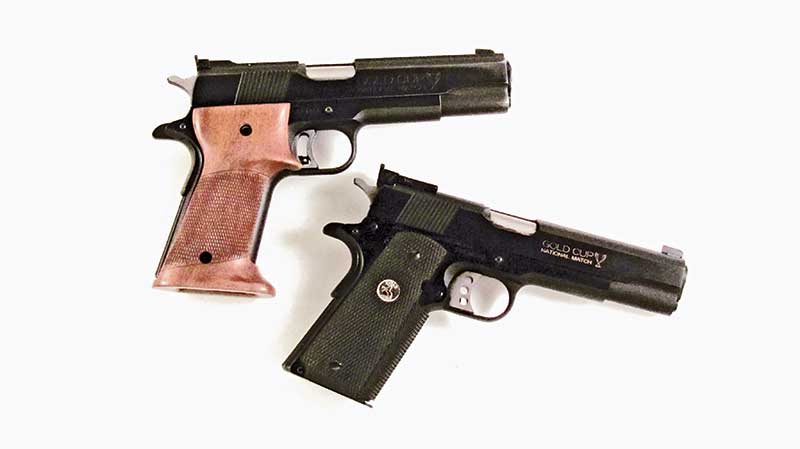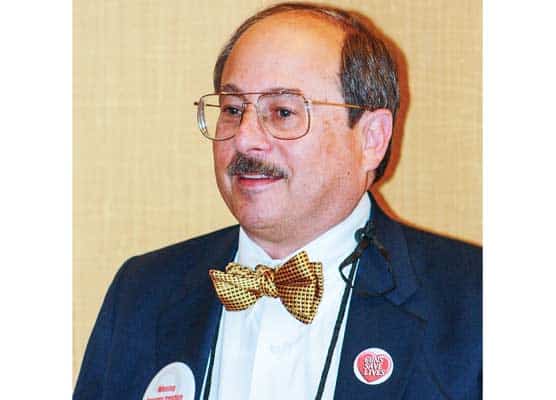Gold Standard
Colt Revives The Gold Cup National Match .45 ACP
Nostalgia or practicality? I’m certainly not sure which one but my shooting spirit is happy to see many old classics have come back. Colt in recent years has brought back the New Frontier which had not been seen since 1982 and now they offer the 1911 Gold Cup National Match.
In the early 1960’s, a time which found me spending my days at the university and my nights in a tire factory to support my family consisting of the young girl who would someday be known as Diamond Dot and three pre-school age children, I lusted, really lusted after a New Frontier and the Gold Cup.
At the time they sold for $140 and $125 respectively, however they just as well might have been several thousand dollars as I had all I could do to come up with $132 for tuition every quarter. The standard operating procedure was to borrow money on my ’58 Chevy each quarter, pay it off, and then start all over again. There would certainly be no New Frontier or Gold Cup in my immediate future. Now they both sell for well over $1,000 each but not only are they now in my reach they are also even better guns than they were way back when. Colt is doing it right and the Gold Cup National Match is the latest example of high Colt quality.
In the past two years I have tested several Colt handguns, a baker’s dozen to be precise. Three of these were Single Action Army sixguns, and two were New Frontiers. On the semi-automatic side of the ledger, one was the new Colt Agent .45 and the other seven were all 1911’s—two .38 Supers, one 10mm Delta Elite and four different .45 ACPs the latest of which is the Series ’80 Gold Cup National Match. As with all of the other Colt 1911 pistols, this one also comes packed in a padded and lockable sturdy plastic box.
In addition to the pistol we find a bushing wrench, an extra light-duty recoil spring and two magazines, one holding 7 rounds and the other 8. I have to admit I am somewhat mystified by this as it says in the instruction booklet the former is for better feeding of semi-wadcutter target loads, while the other is for standard loads. I’m afraid I don’t understand what the difference is and use them interchangeably without a problem.
The Colt 1911 Gold Cup National Match has a beautiful bright blue finish with the rounded top of the slide having a matte finish to cut down on glare. The adjustable sights are about as close to perfection as sights can be consisting of a plain flat black post front sight set in a dovetail matched up with a exceptionally sturdy rear sight looking much like a Bomar although marked “COLT” on the left side. The back of the rear sight is slanted backwards and serrated to cut down on glare. The rear notch is perfectly square and also cut perfectly to match up with the front sight with just the right amount of daylight showing on both sides.
Adjustment screws are large enough you don’t have to search for an exceptionally minuscule screwdriver, and the directional arrows are clearly marked for adjusting windage and elevation. Looking at 1911’s with adjustable sights from several decades ago, you’ll see rear sights sitting quite high. Not this one as it is set deep into the slide. When I started shooting this Colt Gold Cup .45 I only had to adjust the windage screw two clicks and it was ready to go.
Cocking serrations are slanted forward and found below the rear sight on both sides of the slide. The ejection port has been lowered and enlarged for positive ejection of fired brass. On the right side of the slide we find inscribed “GOLD CUP NATIONAL MATCH” along with a logo of a Gold Cup while the left side contains the inscription “SERIES ’80 COLT MK IV GOLD CUP NATIONAL MATCH” along with the standard rampant Colt logo. All the controls are standard Colt 1911 with a slide lock and thumb safety found on the right side of the frame and a 1911A1 grip safety matched up with a flat mainspring housing with longitudinal serrations. The hammer is also standard 1911 style matched up with a lightweight match trigger. Unlike the original Gold Cup which had one long weight-reducing cut, this trigger has three circular cuts along with an adjustable trigger stop. According to my Brownells Trigger Pull Gauge the creep-free trigger measures right at 4-1/2 pounds which is plenty light for my use.
The only thing which causes me pause on the Gold Cup .45 is purely subjective. Regular readers know of my almost obsession for custom grips. It is a rare factory grip which pleases me and this one is no exception. The problem I’m having is they are so wonderfully 100 percent functional I’m almost tempted to forget form. For the use for which this pistol is intended, target shooting, self-defense, or as an everyday working gun, there is absolutely nothing wrong and almost everything right with the grips.
They simply work and work well, however, they don’t stir my emotions. They are wrap-around checkered rubber with silver Colt medallions on each panel and fully cover the front strap again with checkered rubber. For everyday shooting they are totally secure and there is no way this pistol can move in the hand when fired. This may be one of those very rare instances when I let such exceptional function override form. However, since I received this one, I notice Colt now offers the Gold Cup with double-diamond checkered walnut featuring gold Colt medallions. Decisions, decisions.
Great Results
I spent several days really giving this pistol a workout with 15 factory loads. The only time it did not function perfectly could be traced to the ammunition, not the pistol. It is easy to see what an excellent shooting semi-automatic this is. When groups with factory ammo are all sub 2 inches for five shots at 20 yards, I have to say this is about as good as it’s going to get with me doing the shooting. In fact it’s a lot better than I have the right to expect. Several of the groups with factory loads got down very close to 1 inch. What is also interesting, to me at least, is the fact I never installed the light recoil spring as the Gold Cup works fine with all loads using the standard spring.
It took more than three decades for me to come up with my first Gold Cup. This second one is not going to get away, even if at $1,299 it costs nearly 9 times as much as the first version which inspired my lust. Some clear day when I have time, I will shoot both of my Gold Cups side-by-side. I’m not a gambling man, however, if I were I would put my money on this latest version.
Fitz Starts It All
Let’s back up here and take a look at the history of the Gold Cup. Anyone who has anything to do with handguns surely knows the Colt Government Model .45 ACP was adopted by the United States Military in 1911. Like its predecessor the .45 Colt Single Action Army, the 1911 was not designed for precision shooting but rather to deliver a heavy blow quickly. The .45 ACP was every bit as much a manstopper as the .45 Colt of 1873. The 1911 first saw service in the Philippines, went to Mexico with Black Jack Pershing, and then served admirably in WWI. It was a semi-automatic designed to operate under any and all conditions. However, one of those conditions was not target shooting.
Those who couldn’t shoot often claimed it was impossible to hit the broadside of a barn from the inside shooting a 1911. This, of course, is nonsense, however those 1911’s were definitely not target pistols. They were, however, much better than minute of man which is what they were designed to be. With the coming of relative peace in 1918, shooters could look to a different pursuit with the 1911. John Henry “Fitz” Fitzgerald was Colt’s PR man and began working on the Colt 1911, fitting match barrels which greatly improved performance. He was often found at pistol matches, especially Camp Perry, adjusting and tuning Colt revolvers and 1911’s.
With the coming of the .38 Super in 1929, he did the same thing for this high velocity semi-automatic. In 1932 Colt introduced a 1911 specifically designed for target shooting and called it the National Match. Not only was it more tightly fitted than a standard 1911, it also had a match barrel and a match trigger. The original National Match pistols had fixed sights but in 1935 Colt offered the Stevens Adjustable Rear Sight. It was difficult to adjust for windage and elevation, however it was a great improvement over the standard fixed sights. Military armorers also worked at improving the fitting and sights on standard 1911’s. Anyone who has ever fired an original 1911 from the early years knows how difficult it was to shoot with those very hard to see sights.
The Gold Cup Arrives
With the coming of WWII and our subsequent involvement, commercial production of handguns ceased. The National Match was gone. After the war, gunsmith names such as Jimmy Clark, Bob Chow and Frank Pachmayr began to be heard around the country as they built superb 1911’s for target shooting. It was not long before such 1911’s tuned and tightened by these men and others began to replace the Colt and Smith & Wesson .38 Special revolvers in centerfire matches. The National Matches, which had ceased during WWII, were resumed in 1953 and the Springfield Armory (our National Armory still) brought forth 1911’s from inventory and prepared them for use by military personnel in the matches. In 1955 a National Match Pistol was made available to civilians through the Department of Civilian Marksmanship. Then in 1957 Colt brought out the first Gold Cup National Match in .45 ACP and shortly thereafter also in .38 Special, and even .38 Super (although very rare).
The original Gold Cup featured extra material machined from the slide’s interior to reduce weight for better cycling with target loads, an “Accurizor” bushing with fingers for more consistent lockup, and was also fitted with a special Micro rear sight (replaced by the Colt Eliason rear sight in 1965).
It was soon discovered the cutouts were a mistake and the rear sight was not as rugged as it needed to be often shearing the pin holding it to the slide. The Gold Cup was upgraded to the Series 70 without the cutouts and with a collet-style bushing to improve lockup, however, the rear sight was still the same. Eventually the Gold Cup disappeared. It is now back and better than ever.
Gold Cup
Maker: Colt Mfg. Co.
P.O. Box 1868, Hartford, CT 06114
(800) 962-2658
www.colt.com
Action type: Locked breech, semi-auto
Caliber: .45 ACP
Capacity: 7+1, 8+1
Barrel length: 5 inches
Overall length: 8.5 inches
Weight: 37 ounces
Finish: Blue
Sights: Adjustable Bo-Mar-style rear, post front
Grips: Checkered walnut
Price: $1,299
